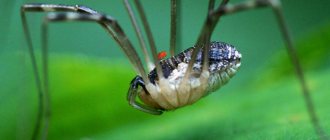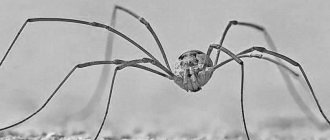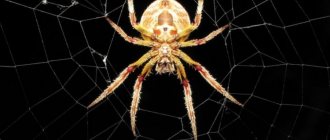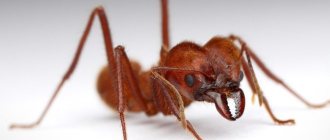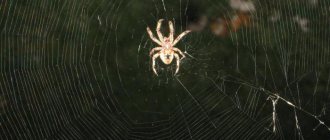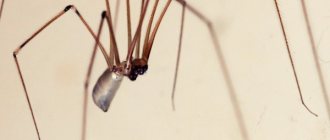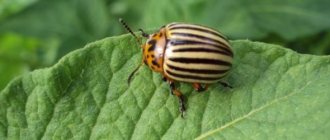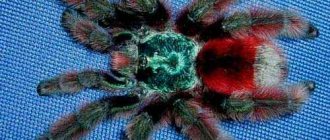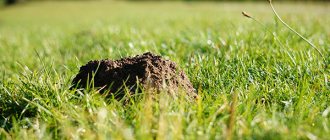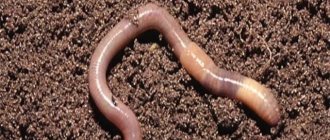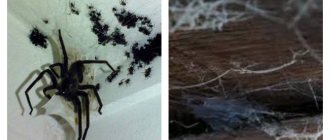The popular nicknames “haymaker”, “mow-hay” and “kosinozhka” are used by two different, although, at first glance, similar creatures. Such names arose from the fact that if you tear off an animal’s paw, it will begin to contract, reminiscent of the movement of a scythe in a hayfield. One of the owners of this name is indeed a spider and lives mainly right in a person’s home. The second one (we will call it in the article the pigtail) has only an appearance reminiscent of a spider, but in fact it is not a spider, and we meet it mainly on the street. In this article I will talk about the features of the haymaker spider, its differences from a simple haymaker (mower spider), and whether we should be afraid of such neighbors.
The haymaker spider and the pigtail spider - can they cause harm? © Paolo Beneventi
Harvesting spider - main features
The haymaker spider, or long-legged spider (Pholcidae), belongs to the spider family and has a small body length, from 2 to 10 millimeters. The length of the legs is usually much longer than the length of the body and in some species can reach 50 millimeters.
This spider has four pairs of long, thin legs. The knee segment is much darker than the main tone of the legs. The cephalothorax and abdomen are two clearly visible structures connected by a visible narrow tube. The head has eight eyes and poisonous, but very small fangs that are not even capable of holding prey. They are intended only for making bites.
The male spider has large palps. The color and size of such spiders can vary, but in the middle zone we are mainly dealing with small gray spiders. In place of the heart (in the upper abdomen) there is a dark spot.
The haymaker spider does not make a web of the traditional radial shape that is characteristic of many spiders. His buildings look untidy and disorderly. In fact, such chaos is the spider’s cunning idea. Its web does not have sticky properties, but, trying to get out, the insect becomes even more entangled in such chaotic structures as in a labyrinth. After which the spider begins to entangle its victim and delivers a fatal bite. He can immediately consume his prey for food, or store it for later.
In nature, such spiders usually set up their traps in caves, animal burrows, under stones and in trees. In human homes, the haymaker can be found near windows, or in corners under the ceiling, where it is difficult to reach while cleaning. As a rule, these spiders choose warm and dry places for their homes, but they can also live in toilets or bathrooms. It is also a traditional inhabitant of sheds, attics and cellars, which is why it is sometimes called the “cellar spider.” On their web, harvestmen usually hang upside down. If the fabric gets too dirty, they throw it away and weave a new house.
Haymaking spiders have another interesting feature - when they are greatly disturbed, they feel the threat of an attack, or their webs have caught too large and dangerous prey, they begin to vibrate strongly with their whole body, swinging their webs. This behavior is designed to scare off the enemy and become unnoticed against the backdrop of the shaking web. Because of this, they also received the nickname “vibrating spider”.
Haymaking spider or long-legged spider
Special Features
If you grab a haymaker's leg, it will easily come off. For a few more minutes, the severed limb will make convulsive movements.
The ease with which the limb comes off creates the misleading impression that the legs are loosely attached to the body. In fact, this is not true. The harvester deliberately separates the limb. The paw comes off like a lizard's tail. This autotomy helps the haymakers to escape from enemies.
We suggest you familiarize yourself with How to wash the inside of a bottle of greens: simple and quick methods
The predator first stumbles upon the paws, and then is distracted by the moving limb while the animal flees. Therefore, you can often find individuals who have an incomplete number of legs.
Harvesting Spider Menu
Harvesters eat almost all insects (flies, beetles, butterflies); in addition, they include other spiders (for example, the house spider), as well as ticks and even other individuals of their species in their menu. The spider lives in the house all year round. In winter, when there are almost no insects left, the spider has to look for prey among its closest relatives.
Usually his prey is other individuals of harvesting spiders - when he is hungry, he has no other alternative. During seasons when the overall insect population is minimal, the spider begins to undertake “reconnaissance expeditions” around the house. As soon as a spider finds the web of its relative, it portrays itself as prey, swinging the web with its long legs. When the owner of the web runs out at the signal, the spider inflicts a fatal bite on him.
Unlike most other spiders, harvest spiders breed year-round. Once the male is ready to mate, he goes in search of a female. When he finds a bride, he immediately lets her know about his “noble intentions.” This also occurs in the form of vibration with the whole body on its web. As the female approaches, the male strokes her first pair of legs, which quickly wins the favor of his future wife.
If mating goes smoothly, the male is usually not eaten by the female, but remains next to her until he dies a natural death. The male harvester lives only one year, while the female lives 3 times longer.
Young spiderlings are transparent and have short legs. Even after several molts, the spiders remain with their mother, and she carries them between her jaws. Growing up spiderlings practice catching tactics with their brothers and sisters, eventually leaving their mother and starting to live on their own.
Harvesters eat almost all insects. © Classiccardinal
Classification
Systematics divides these creatures into four main suborders.
Cyphophthalmi
A small suborder containing about 220 genera. These are primitive harvesters, whose fossil remains are found by paleontologists in Carboniferous deposits.
Representatives of this suborder have an oval oblong body, no more than 2 mm long. The legs are short. They live in the tropics and subtropical regions of Africa, South America and Eurasia.
The suborder includes two large families - Sironidae and Stylocellidae.
Eupnoi
This suborder includes the pigtails with the longest limbs. They have large eyes, a soft belly and special vitality.
They easily tolerate cold, being active until the first frost. Due to their special frost resistance, they settled throughout the planet. They are found on mountain slopes, deciduous and coniferous forests.
The suborder has 1,800 species, united in two families - Phalangiidae and Caddidae.
Dyspnoi
The most ancient representative of this suborder, Ameticos scolos, was discovered in coal deposits in France. Now it includes 320 modern species.
Very motionless species that sometimes seem lifeless. They live in the southern regions of Russia, in the vast expanses of Europe and Southeast Asia.
The legs are short. There are species that have an elastic abdomen, but there are also armored coverings. The suborder includes four families - Ischyropsalidae, Nemastomatidae, Trogulidae, Dicranolasmatidae.
Laniatores
The most numerous tropical suborder. Includes more than 4 thousand species. It is also the most mysterious, as it is the least studied.
Representatives of the suborder have a brightly colored body with a very hard protective covering. The abdomen is characterized by small bumpy growths. The settlement area is extensive. Found in the tropics of Africa, South America, and Australia.
A large population lives in India. The largest suborder includes five families - Cosmetidae, Gonyleptidae, Triaenonychidae, Oncopodidae, Phalangodidae.
Is the haymaker spider dangerous for humans?
I don’t know who invented the myth about the terrible poisonousness of this tiny spider. Perhaps such a horror story was invented by children who love to scare each other. Of course, this spider also has venom glands, but the degree of its poisonousness to humans is not even considered, since its tiny fangs are not capable of cutting through human skin. Moreover, they are so small that spiders select only the most tender parts of the victim to bite.
Can these long-legged neighbors help us? Haymaking spiders have a very varied menu. In short, they can catch almost every insect that comes into your home, including flies and mosquitoes. If such a spider settles near a window, then its web will also catch insect pests that damage seedlings and indoor flowers. Thus, these spiders regulate the population of insects, including harmful ones, and other spiders in the house.
The web of this spider does not have the traditional intimidating appearance, and in some places, in principle, you can put up with it if you perceive this spider as an assistant in the fight against unwanted insects and other spiders. In addition, this subtle “translucent” spider does not have a completely intimidating appearance, like, say, a house spider. Even people who are afraid of spiders can be relatively calm about the harvestman. This means that, judging by the totality of its features, the haymaker spider is not the worst neighbor.
Getting rid of it using chemicals
You can also fight spiders with chemicals. “Butox-50” has proven itself well, which needs to be sprayed in places where such insects are most concentrated, close the doors tightly and leave for about 20 minutes. After treatment, the room needs to be ventilated and wet cleaned. The drug "Neoron" is effective, the use of which is contraindicated in the kitchen to avoid its contact with food and utensils. You can destroy spiders using Tarax, which when sprayed creates a film of the active substance. Spiders die almost immediately upon contact with it. It is enough to treat their locations with a spray bottle.
You can place special dry trap tablets in the corners, the smell of which attracts arachnids, and the poison they contain kills.
Differences between the moss spider and the haymaker spider
Another haymaker (Opiliones) - the mosstail - belongs to the order of arthropods from the class of arachnids, but is not a spider. This creature usually does not live in human homes, but we often see it in gardens and vegetable gardens. In some countries, such a harvester is also often called a “harvester”, since they are most often observed in the fall during harvesting.
Unlike the harvest spider, this arthropod has a uniform oval fused body, whereas in spiders it consists of two noticeable segments. The legs of the harvestman have an extraordinary length in relation to the body and can even reach 16 centimeters with a body size of 1-5 millimeters. The color is usually gray, brown or black.
Unlike eight-eyed spiders, they usually have one pair of eyes. In addition, harvestmen do not weave webs and do not have poison. But they have glands that secrete a secretion with a sharp unpleasant odor, due to which they are rarely eaten by animals or birds.
Harvesters are omnivores, they eat insects, spiders, ticks, slugs, snails and plant material, and can also feed on particles of manure. These animals are scavengers, but can also behave as predators. At the same time, they feed not only on the liquid internal contents, like spiders, but also eat the solid parts of the prey.
Kosinozhki lose one of their limbs not only as a result of cruel childhood games. Often, when attacked, harvesters independently throw their leg away from their body in order to distract a potential predator. For some time (up to half an hour) after separation, the limb will twitch. This twitching, reminiscent of the work of a scythe, probably distracts the attention of predators and allows the harvester to escape. Unfortunately, a lost leg cannot be replaced, but the animal often adapts to its absence.
Another defense mechanism exhibited by some species is hopping. The braids rapidly vibrate the entire body, which can distract or frighten the predator. In addition, harvestmen sometimes gather in large groups that look like hairy furballs due to the many long, thin legs, with the haymakers interlocking with their legs. The creation of such clusters provides the arthropods with warmth and humidity, as they quickly become dehydrated, and can also confuse predators.
Braided leg. © Chris Stringfellow
Status and population
The spider population is quite large, because it lives in almost every house. Tenacious creatures are not afraid of poor environmental conditions. But this applies only to those species that live near humans.
The individuals remaining in the wild live much less than domestic ones. The duration of existence of the latter is only two years. And the wild ones don’t live up to this age. They live in small areas, concentrated mainly in the tropics. But they are not in danger of extinction. Spiders easily adapt to new conditions, so it is not difficult for them to find suitable housing.
But they have one serious enemy - man. The small body and long legs of the haymaker irritate people, and some are very frightened. And in other cases, the cobwebs with which it weaves around the corners of the house interfere. Sometimes it comes to the point that during rescue the arthropod tears off its legs, which are not restored in adult individuals. But after half an hour the wound heals, and the spider itself feels muscle twitching.
How are mowers useful in the garden?
Mainly, harvesters go hunting at night, looking for small insects, eggs or decaying plant or animal remains on the ground or on plants. Their food preferences include ants, mosquitoes, caterpillars, slugs, and snails. Agree, these are not the most pleasant guests of our garden. In addition, sourbugs readily destroy the eggs of various pests.
Haymakers, as scavengers, are garden orderlies, processing various organic waste. Thus, the arthropod harvester is our assistant on the site. And if you meet such a creature resting in the midday heat, then you need to leave it alone. And even more so, you shouldn’t be afraid of him!
Who needs long legs?
The harvestman has long legs, which he can easily handle. Nature has thought out a unique principle for controlling these limbs. The legs are bent with the help of the muscle that pulls the tendon (muscular-mechanical action). They unbend from the pressure of the hemolymph, which accumulates inside (hydraulic action). Such a well-oiled mechanism is incredibly economical: it avoids the need for many small muscles. A haymaker can easily wrap its paw around any blade of grass or small pebble. The walking pigtail easily overcomes obstacles and can move even in hot or cool weather, carrying its body high above the surface.
The mechanism of movement of the haymaker interested specialists in the field of bionics (applied science that studies the use in technology of the principles of functioning of living forms). Kosinozhki give ideas to writers and artists, they are developed by specialists who are working on creating... walking vehicles for studying other planets.
At the first danger, the haymaker easily loses his limbs. The wound heals instantly, so there is no loss of hemolymph. The severed leg continues to twitch for some time (up to half an hour). This occurs due to the voluntary contraction of special muscles. Lizards act in a similar way when they give their tails to the enemy. Autotomy (this is what the “voluntary” loss of body parts is called) often saves an animal from death. Haymakers losing part of their legs is a common occurrence. Their legs, unfortunately, do not recover.
The longest is usually the second pair of legs. The male common harvester has up to 54 mm. These legs read information about the state of the ground, stone or other support. Red dots on the legs or body are the larvae of ticks that have attached themselves to the braids.
origin of name
The arthropod's paws are easily torn off, and the damaged area quickly heals without causing harm. The leg continues for some time to make movements that resemble a scythe during haymaking. This is where the name comes from: goat's leg, haymaker, spider's leg, goat's leg
The paw attracts the enemy's attention while the spider runs away. Natural enemies are other arachnids and birds. The Latin name opiliones literally means "shepherd"
The associations arose due to the long legs resembling stilts. In ancient times, shepherds often used stilts to make it easier to keep track of their flock. An American writer named the spider opiliones due to its massive distribution in pastures.
A tick is also called a haymaker, which has nothing in common with an arachnid. According to genetic studies, the pigtail's DNA is more similar to scorpions than to spiders.
Lifestyle, habitats
A spider with long thin legs is ubiquitous. It is found in forests, meadows, fields, near rivers, in outbuildings, abandoned buildings, and residential buildings. Some species live in deserts and mountains.
During the day, the koshisena spider hides in shady places away from direct sunlight. Often found on the walls of a building with its legs splayed to the side.
On a note!
At the sight of an enemy, the haymaker flees and develops a fairly high speed. During the day, the house spider sits in a shaded place - in the corners of the room, in the bathroom, pantry, under furniture. At night it goes out in search of food.
Reproduction
The mating season lasts from early July to late August. The method of fertilization is internal, more reminiscent of insects. The fertilized female lays eggs in the soil. Reproduces up to 600 pieces at a time. The young generation, the eggs, remain to overwinter. One population appears per year, rarely two. The spider lives no more than 2 years.
Cubs differ little in appearance from adults. A spider with a small body and large legs. The maturation period lasts several days. A young haymaker moults 7 times. Gradually increases in size and acquires a darker color. At the last stage of development, puberty occurs.
Interesting!
There are no mating games, but fights between males occur quite often. Males have maternal instinct - they protect egg laying from females who are capable of devouring the young.
